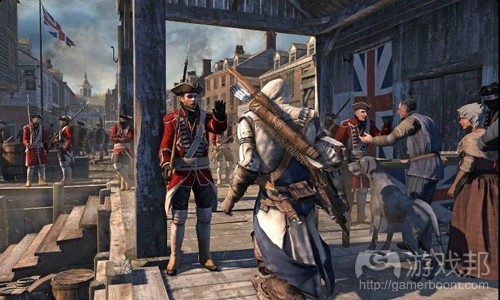Alex Hutchinson分享创造逼真城市的5个技巧
作者:Frank Cifaldi
经常有人说在《侠盗猎车手》中,真正的明星不是游戏的主角Niko Bellic,而是自由市本身。自由市是一座模仿纽约市虚构出来的大都市。
在当今的开放性世界游戏中,创造一座逼真的城市是开发者面临的最艰巨的挑战之一。做得不好,玩家觉得自己就像走在毫无生气的电视画面前,身后是劣质的道具和虚假的建筑;做得好,玩家会沉浸于游戏世界,立刻忘记自己只是在玩游戏。
多亏了《刺客信条》系列,育碧成为最擅长创造虚拟城市的游戏公司之一。Alex Hutchinson是即将发布的《刺客信条3》的创意总监,他认为制作一个让人感觉真实可信的城市是“最艰难的事之一”。以下是他传授的5条技巧。
1、双重反应
假设在开放世界中,NPC对玩家的反应:在《侠盗猎车手》中,你朝人群开枪,行人会尖叫着跑开,警察会追上你,有些比较强悍的还会反过来朝你开枪。
对于《刺客信条3》,育碧专注的是双重反应:NPC们不仅明白玩家的举动,还知道玩家举动与自己的关系。Hutchinson的解释是:
“如果有人雇佣你去杀角色A,你杀了,人们的反应是,‘很好,正如我愿。’但之后你开始随便杀人,人们就害怕了,以为你丧心病狂了。但那些没有牵涉到对话中的人在这两种情况之下都会感到恐慌。
这么解释听起来很简单,但Hutchinson坚信这是“尚无人能真正解决的难题之一”,包括他的团队在内。
2、随机行为
目前,《刺客信条》系列中的人群大概是游戏中最逼真的了:行走在游戏场景中,你会看到无数人以真实的方式活动着。
这里的技巧在于,NPC是半随机刷出的。居住在某个地区的行人的活动,是随机从大量可能行为中抽取的。这意味着,你不太可能注意到他们当中有很多人出现在完全相同的动画物循环中。
Hutchinson承认,这是该系列游戏开发中投入最多的部分,但也是使城市真实可信的关键要素。
3、变体比复杂度重要
尽管只是少数玩家爱找碴,想破解游戏,但大多数玩家还是会按预期的方式玩。在开放世界的场景中,这意味着玩家会快速地穿过人群,从A点抵达B点。
Hutchinson指出,大多数玩家看随机NPC的时间最长只有6秒,所以要好好利用这一点!不可太专注于循环动画持续时间超过6秒的复杂AI程序,而要更注重不同的、更短动作的大量变体。
4、城市第一,道具其次
至今为止,每一款《刺客信条》都是根据历史上真实存在的地图构建的,之后再考虑如何填入游戏道具部分。
让游戏完全按照现存的地图来布局是不太可能的,即使是像《刺客信条》这样的游戏,也必须先重点设计逼真的城市,然后再增加城市的游戏趣味。
5、重点修饰任务区域
你可能会很想把整个城市变成值得探索的地方,如果只是进行少量修饰,那就是可行的。但要记住,在游戏中,只有任务发生地才是最吸引用户注意力,最能够让开发者盈利的区域。
好好布置城市,加点必要的道具,但要把主要精力放在使任务区域变得更有趣的地方上,因为那才是玩家的注意力所在。(本文为游戏邦/gamerboom.com编译,拒绝任何不保留版权的转载,如需转载请联系:游戏邦)
5 tips for making more believable open world cities
by Frank Cifaldi
July 18, 2012
It has often been said that the true star of Rockstar’s groundbreaking Grand Theft Auto IV was not lead character Niko Bellic but, rather Liberty City itself, a fictional metropolis modeled after New York City.
Creating a breathing, living city is one of the toughest challenges facing developers of open world games today: get it wrong, and your player feels like she’s walking through a lifeless television set with cheap props and false fronts for buildings. Get it right, and she’ll be absorbed enough in your world to momentarily forget she’s playing a game at all.
Ubisoft Montreal is among the best in the business at creating believable cities thanks to its Assassin’s Creed series. We sat down with Alex Hutchinson, creative director of the upcoming Assassin’s Creed III, for his tips on making a city feel alive. He tells us it’s “one of the hardest things you could possibly do,” but managed to offer the following.
1. Two-tiered reactions
It is a given that NPCs in open world cities will react to your actions: fire into a crowd in any Grand Theft Auto, and pedestrians will run screaming, cops will come after you, and some of the rougher types might even fire back.
What Ubisoft Montreal has been focusing on for the Assassin’s Creed is in two-tiered reactions: NPCs that understand not only the action the player has committed, but how it relates to them. Hutchinson explains:
“If someone hires you to kill Character A, and you do it, and they react like, ‘Good, that’s what I asked you to do.’ But then you go and kill some other random person and they’re going to freak out, like you’ve lost your mind. Whereas someone who wasn’t involved in that conversation would freak out at both of the instances.”
It sounds simple when explained that way, but Hutchinson insists that it is “one of those things that no one in games yet has truly solved,” including his own team.
2. Random behavior from a pool
The Assassin’s Creed series has perhaps the most believable crowds in games today: walk through an environment, and you’ll see countless people going about their lives in realistic ways.
The trick is that these NPCs are spawned semi-randomly. As pedestrians populate an area in the game, they are randomly assigned behavior from a large pool of possibilities, meaning it’s unlikely you’ll notice too many of them going through the exact same animation cycles.
It’s an expensive part of the series’ development, Hutchinson admits, but it’s a key ingredient in making a city feel alive.
3. Variety over complexity
Though a minority of your players will be troublemakers trying to break your game and peek behind the curtains (including this author), most of them will play your game just as intended. And in an open world environment, that means running quickly through the crowds from point A to point B.
Take advantage of this! Most players will only look at your random NPCs for six seconds, max, Hutchinson tells us. So instead of focusing on a complex AI routine full of animation cycles that last much longer than that, put more emphasis on a wide variety of different, shorter actions.
4. City first, props later
Every Assassin’s Creed to date has laid out its cities based on actual historical maps, worrying about filling it in with gameplay setpieces later.
It’s unlikely that your game will strictly adhere to an existing map, but it’s a good takeaway: even a game like Assassin’s Creed focuses on a believable city layout first and worries about making that city fun to play in later. Which brings us to our final tip:
5. Save your polish for mission areas
It’s tempting to make your entire city a playground for explorers, and adding little touches will be rewarding, but remember that the places in your city where actual missions take place will give you the most bang for your buck.
Have fun decorating the city and placing clever props where you can, but focus most of your energy on making the mission areas as fun as you can, as that’s where players will be focusing the most attention.(source:gamasutra)









































